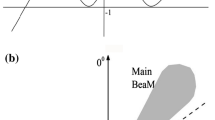Abstract
This paper presents the performance of adaptiveantennas in a 1/3 reuse frequency hopping GSM networkusing conventional beamforming. It mainlyfocuses on C/I improvement for the purpose of capacityenhancement. The performance evaluation has beenconducted by means of network computer simulations,where measured time-space radio channel impulseresponses are applied for the desired user in thenetwork. Measurements with an M = 8 element uniformlinear array were conducted in the cities ofAarhus, Denmark, and Stockholm, Sweden. The simulatedC/I improvement shows an almost 10 * log10(M)behavior for low azimuth spread values. For largevalues of azimuth spread (relative to the antennabeamwidth), the performance gain is reducedsignificantly. For an azimuth spread of10°–12°, which has been measured inurban macro-cellular environments, the C/I gain forM = 8 is reduced to approx. 5.5–7.5 dB (which should becompared to the theoretical value of 9 dB for a pointsource). The designed DoA algorithm is very robust toco-channel interference and only a small degradationin performance is observed for single element C/I downto approx. –8 dB. We conclude that the designedbeamforming implementation facilitates a potentialcapacity gain of ×3 in a 1/3 reuse FH-GSM network foran array size of M = 4–6.
Similar content being viewed by others
References
S. Anderson, U. Forssén and J. Karlsson, “Ericsson/Mannesmann GSM Field-Trials with Adaptive Antennas”, Proc. of EPMCC'97, pp. 77–85.
M. Tangeman, U. Bigalk, C. Hoek and M. Hother, “Sensitivity Enhancements of GSM/DCS 1800 with Smart Antennas”, Proc. of EPMCC'97, pp. 87–94.
A.J. Poulraj and C.B. Papadias, “Space-Time Processing for Wireless Communications”, IEEE Signal Processing Magazine, pp. 49–83, 1997.
J.H. Winters, “Smart Antennas for Wireless Systems”, IEEE Personal Communications, pp. 23–27, 1998.
R. Kohno, “Spatial and Temporal Communication Theory Using Adaptive Antenna Array”, IEEE Personal Communications, pp. 28–35, 1998.
F. Kronestedt and S. Andersson, “Migration of Adaptive Antennas into Existing Networks”, Proc. of IEEE VTC'98, Ottawa, pp. 1670–1674.
U. Forssén, J. Karlsson, B. Johannisson, M. Almgren, F. Lotse and F. Kronestedt, “Adaptive Antenna Arrays for GSM900/DCS1800”, IEEE Proc. of VTC '94, Stockholm, Sweden, pp. 605–609.
P. Kenington and W. Slingsby, “Multi-Carrier Linear Power Amplifier Design for a DCS1800 Adaptive Antenna System”, Proc. of TSUNAMI II Final Workshop on Adaptive Antennas, Copenhagen, Sept. 1998.
F. Kronestedt and S. Andersson, “Migration of Adaptive Antennas into Existing Networks”, IEEE Proc. of VTC'98, Ottawa, May 1998, pp. 1670–1674.
Technical Annex, “Technology in Smart Antennas for Universal Advanced Mobile Infrastructure Part II (TSUNAMI 2)”, EU, ACTS Project Number AC020, March 1998.
“Traffic Loading of GSM Networks”, European Radiocomunications Office, April 1998.
W.C. Lee, Mobile Communications Engineering, McGraw-Hill, Inc., 1976.
F. Kronestedt and S. Andersson, “Adaptive Antennas in Frequency Hopping GSM”, IEEE Proc. of ICUPC, Oct. 1998, pp. 325–329.
F. Frederiksen, P.E. Mogensen, K.I. Pedersen and P.L. Espensen, “Testbed for Evaluation of Adaptive Antennas for GSM and Wideband CDMA”, Proc. of COST 252/259 Joint Workshop, Bradford, April 21–22, 1998, pp. 171–181.
K.I. Pedersen, P.E. Mogensen and B.H. Fleury, “Power Azimuth Spectrum in Outdoor Environments”, IEE Electronics Letters, Vol. 33, No.18, pp. 1583–1584, 1997.
U. Martin, “A Directional Radio Channel Model for Densely Built-Up Urban Areas”, Proc. 2nd EPMCC, Bonn, Germany, Oct. 1997, pp. 237–244.
M. Tangemann and M. Beach et al., “Report on the Benefits of Adaptive Antennas for Cell Architectures”, RACE TSUNAMI R2108/SEL/WP3–4/DS/P/029/b1, May 1995.
P.E. Mogensen, P. Zetterberg, H. Dam, P.L. Espensen and F. Frederiksen, “Algorithms and Antenna Array Recommendations”, Technical Report AC020/AUC/A1.2/DR/P/005/b1, 1997.
J.P. Shelton and K.S. Kelleher, “Multiple Beams from Linear Arrays”, IRE Trans. on Antennas and Propagation, pp. 154–161, 1961.
B. Johannisson, B., “Active and Adaptive Base Station Antennas for Mobile Communication”, Proc. of Antenna'97, Sweden.
P. Zetterberg, “Mobile Cellular Communications with Base Station Antenna Arrays: Spectrum Efficiency, Algorithms and Propagation Models”, Ph.D. Thesis, KTH, Stockholm, ISSN 1103–8039, 1997.
B.D. Veen and K.M. Buckley, “Beamforming: A Versatile Approach to Spatial Filtering”, IEEE ASSP Magazine, pp. 4–24, 1988.
J.H. Winters, “Optimum Combining in Digital Mobile Radio with Co-Channel Interference”, IEEE Journal on Selected Areas in Communications, Vol. SAC-2, No.4, 1984.
R. Arnott and S. Ponnekanti, “Experimental Investigation of Adaptive Antennas in a DCS-1800 Mobile Network”, Proc. of 3rd ACTS Mobile Communication Summit, Rhodes Greece, June 8–11, 1998, pp. 535–543.
T. Howard, C.M. Simmonds, P. Darwood, M.A. Beach, R. Arnott, F. Cesbron and M. Newman, “Adaptive Antenna Performance in Mobile Systems”, Report AC020/ORA/WP3/DS/P/008/b1, June 30, 1998.
M. Pokkila and P. Ranta, “Channel Estimator for Multiple Co-Channel Demodulation in TDMA Mobile Systems”, Proc. of EMPCC'97, Bonn, Sept. 1997.
K.I. Pedersen, P.E. Mogensen and B.H. Fleury, “A Stochastic Model of the Temporal and Azimuthal Dispersion Seen at the Base Station in Outdoor Propagation Environments”, IEEE Trans. on Vehicular Technology (submitted), 1998.
K.I. Pedersen, P.E. Mogensen and B.H. Fleury, “Spatial Channel Characteristics in Outdoor Environments and their Impact on BS Antenna System Performance”, IEEE Proc. of VTC'98, Ottawa, Canada, May 18–21, 1998, pp. 719–723.
S. Ratnavel, A. Paulraj and A.G. Constantinides, “MMSE Space-Time Equalization for GSM Cellular Systems”, IEEE Proc. of VTC, 96, Atlanta, April 1996, pp. 331–335.
J.H. Winters, “The Impact of Antenna Diversity on the Capacity of Wireless Communications Systems”, IEEE Trans. on Communications, Vol. 42, No.2/3/4, pp. 1740–1751, 1994.
European Digital Cellular Telecommunications System, ETSI, GSM 05.XX, ETS 300 XXX.
UTRA UMTS Physical Layer Description (v04, 1998–06–25), 1998.
Author information
Authors and Affiliations
Rights and permissions
About this article
Cite this article
Mogensen, P.E., Espensen, P.L., Zetterberg, P. et al. Performance of Adaptive Antennas in FH-GSM Using Conventional Beamforming. Wireless Personal Communications 14, 255–274 (2000). https://doi.org/10.1023/A:1008975420402
Issue Date:
DOI: https://doi.org/10.1023/A:1008975420402




